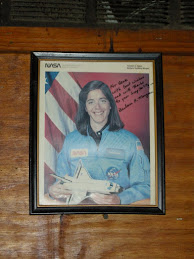
As a parting gift, Pedro introduced us to several of his friends who work at JSC, and they gave us even more insider tours. We started with Luis Ramirez, who works in the data processing discipline of the shuttle program's Mission Control Center. So the room we could only see from behind glass yesterday? Yup. We were in there.
Luis talked us through a simulation of a shuttle landing that his colleagues were supporting from their consoles. He said the shuttle's systems are divided up (main engines, propulsion, trajectory, electronics, fuel cells, life support, etc.), and teams of people are assigned to specific disciplines. They are trained to know their systems absolutely and must be able to anticipate and mitigate problems on the fly and under stress.
"The best simulations are the ones where you end up saying, 'That was tough. My brain hurts.' " Luis laughed. "Because you either learn a valuable lesson that you'll probably never make again, or you feel really proud of what you've accomplished."
One proud thing Luis helped us accomplish was revisiting the historic Apollo MCC, where we were able to get close to actual paperwork from the Apollo 11 mission to the moon. Heady stuff.
Then we met up with Danny Carraho. He worked for years on the electronic components of the ARED (Advanced Resistance Exercise Device), which currently is keeping astronauts fit on the International Space Station. Sandra Magnus, who came down last week after 134 days, used the ARED for several months and said she was in great shape. Having seen it go from concept to reality, Danny said watching it be used for the first time was "very scary."
"It's like watching your kid ride a bike for the first time," he said.
Danny is now focusing on the inner-workings of lunar habitation mock-ups, and we were able to check out several concepts. While the return to the moon won't happen for many years, Danny said the wait doesn't dull the excitement of the job.
"I still feel like I just started. I feel like I'm doing something good here. Nobody else does this in the world," he said. "I don't have trouble coming to work everyday."

We left Danny for another mock-up facility where some of the students got to operate a powerful robotic arm nicknamed Dexter. We also got to see a lunar rover prototype called the Chariot that is part of NASA's plan to return to the moon in 2020. Engineer Mason Markee explained that he and his colleagues try to buy whatever they can off the shelf, so the tires are not custom. But each wheel module has its own axis and suspension, making the Chariot the "ultimate off-road vehicle."
"Inside it's a smooth ride while it's going over really rough terrain," Mason said. "You can't even follow it with a truck."
The photo below features Mason kicking a tire. Apparently, NASA engineers do that too.
The last tour of the day was of the Ad Astra Rocket Company, its enormous vacuum chamber and VASIMR, or Variable Specific Impulse Magnetoplasma Rocket. Plasma physicist Ben Longmier explained that plasma thrusters have a lot of potential when it comes to space travel and transport. Using ionized gas to create a plasma propellant, the VASIMR gets more thrust more efficiently than a chemical rocket. As usual, anything to do with rockets had the team enthralled (as did the 7,000 pound steel door on the vacuum chamber, which was formed with explosives).







































No comments:
Post a Comment